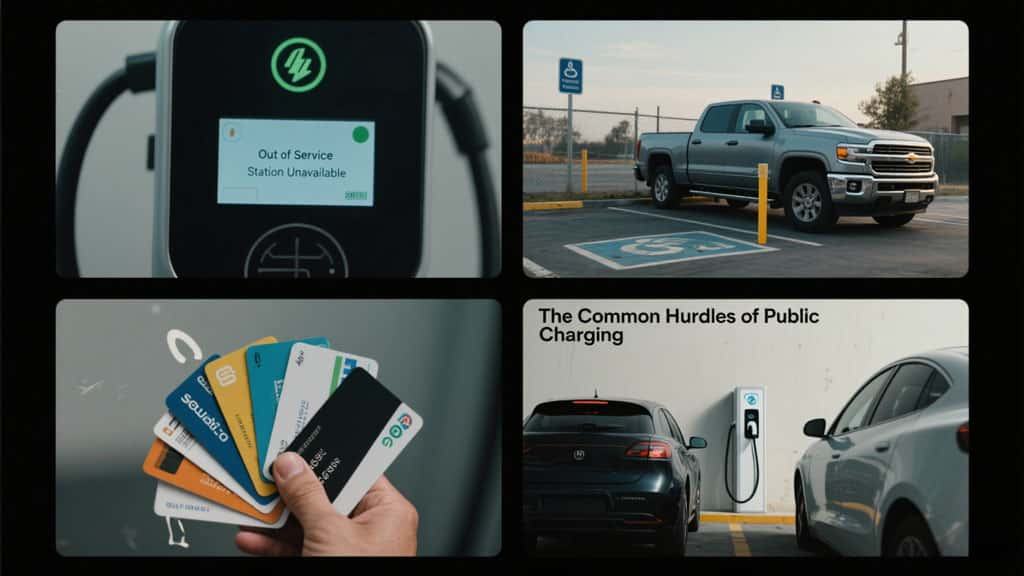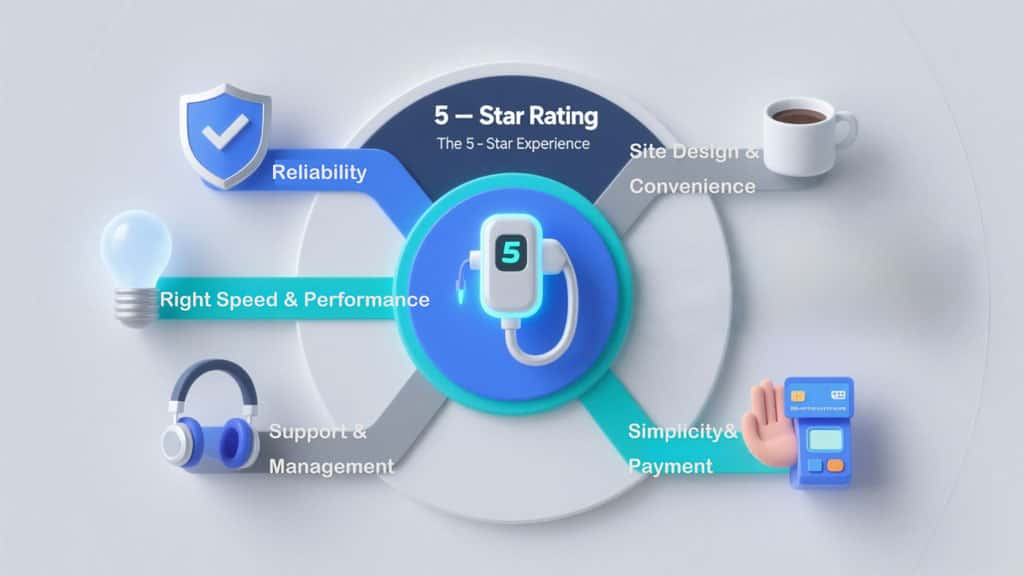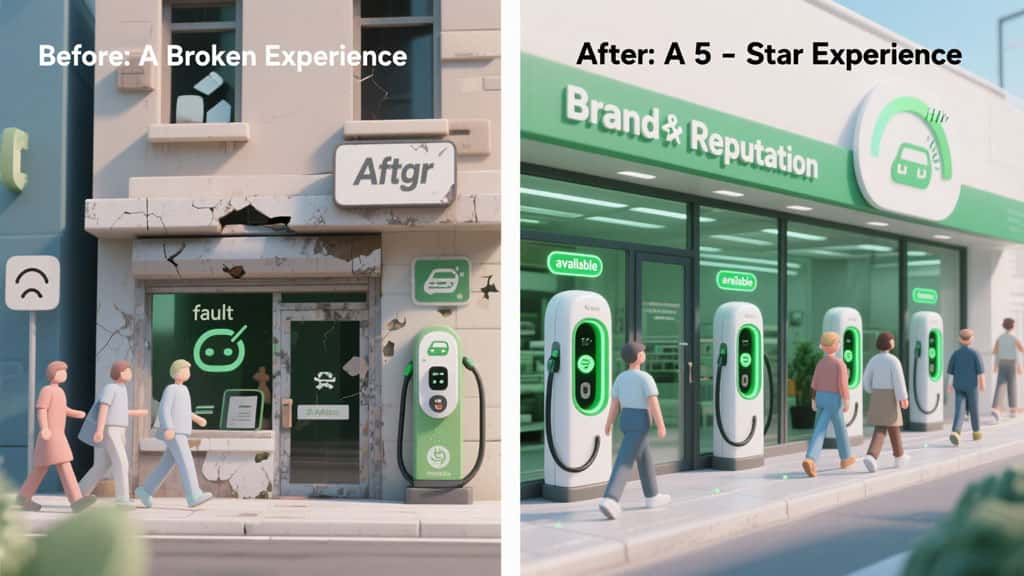The electric vehicle revolution is here, but it has a persistent problem: the public EV charging experience is often frustrating, unreliable, and confusing. A recent J.D. Power study found that 1 in every 5 charging attempts fails, leaving drivers stranded and damaging the reputation of the businesses that host these chargers. The dream of seamless electric travel is being undermined by a reality of broken stations, confusing apps, and poor site design.
This guide tackles this problem head-on. We will first diagnose the root causes of the poor charging experience. Then, we will provide a clear, actionable 5-Pillar Framework for businesses and property owners to create a reliable, user-friendly, and profitable charging destination. The solution lies in focusing on:
1.Unshakable Reliability
2.Thoughtful Site Design
3.The Right Performance
4.Radical Simplicity
5.Proactive Support
By mastering these five pillars, you can turn a common customer pain point into your greatest competitive advantage.
Why Is the Public EV Charging Experience Often So Bad?

For many drivers, the public charging experience doesn't match the high-tech feel of their cars. Data from across the industry paints a clear picture of the frustration.
•Widespread Unreliability: The previously mentioned J.D. Power 2024 U.S. Electric Vehicle Experience (EVX) Public Charging Study highlights that 20% of public charging attempts fail. This is the single biggest complaint from EV drivers.
•Payment Problems: The same study found that issues with payment systems are a major cause of these failures. Drivers are often forced to juggle multiple apps and RFID cards.
•Poor Site Conditions: A survey by PlugShare, a popular charging map app, often includes user check-ins that report poor lighting, broken connectors, or chargers blocked by non-EVs.
•Confusing Power Levels: Drivers arrive at a station expecting a fast charge, only to find the actual output is much slower than advertised. According to the U.S. Department of Energy, this mismatch between expected and actual speed is a common source of confusion.
The Root Causes: A Systemic Issue
These problems don't happen by accident. They are the result of an industry that grew incredibly fast, often prioritizing quantity over quality.
•Fragmented Networks: There are dozens of different charging networks in the U.S., each with its own app and payment system. This creates a confusing experience for drivers, as noted in reports by McKinsey & Company on the EV charging infrastructure.
•Neglected Maintenance: Many early charger deployments lacked a long-term maintenance plan. As the National Renewable Energy Laboratory (NREL) has pointed out, hardware reliability degrades without proactive service.
•Complex Interactions: A charging session involves complex communication between the vehicle, the charger, the software network, and the payment processor. A failure at any point in this chain results in a failed session for the user.
•"Race to the Bottom" on Cost: Some early investors opted for the cheapest possible hardware to deploy more stations quickly, leading to premature failures.
The Solution: A 5-Pillar Framework for a 5-Star Experience

The good news is that creating an excellent EV charging experience is achievable. Businesses that focus on quality can stand out and win. Success rests on executing five key pillars.
Pillar 1: Unshakable Reliability
Reliability is the foundation of everything. A charger that doesn't work is worse than no charger at all.
•Invest in Quality Hardware: Choose electric vehicle equipment from reputable manufacturers with high IP and IK ratings for durability. Research from sources like the Idaho National Laboratory shows a direct link between hardware quality and operational uptime.
•Demand Proactive Monitoring: Your network partner should be monitoring your stations 24/7. They should know about a problem before your customers do.
•Establish a Maintenance Plan: Just like any other piece of critical equipment, chargers need regular service. A clear maintenance plan is essential for long-term reliability.
Pillar 2: Thoughtful Site Design & Convenience
The experience begins before the driver even plugs in. A great location feels safe, convenient, and welcoming.
•Visibility & Lighting: Install chargers in well-lit, highly visible locations near the entrance of your business, not hidden in a dark corner of the parking lot. This is a core principle of good EV Charging Station Design.
•Amenities Matter: A recent Boston Consulting Group report on charging noted that drivers highly value nearby amenities like coffee shops, restrooms, and Wi-Fi while they wait.
•Accessibility: Ensure your station layout is ADA compliant to serve all customers.

Pillar 3: The Right Speed at the Right Place
"Faster" is not always "better." The key is matching the charging speed to your customers' expected dwell time.
•Retail & Restaurants (1-2 hour stay): A Level 2 charger is perfect. Knowing the right Amps for a Level 2 Charger (typically 32A to 48A) provides a meaningful "top-up" without the high cost of a DCFC.
•Highway Corridors & Travel Stops (<30 min stay): DC Fast Charging is essential. Drivers on a road trip need to get back on the road quickly.
•Workplaces & Hotels (8+ hour stay): Standard Level 2 charging is ideal. The long dwell time means even a lower-power charger can provide a full charge overnight.
Pillar 4: Radical Simplicity (Payment & Use)
The payment process should be invisible. The current state of juggling multiple apps is a major pain point, as confirmed by a recent Consumer Reports survey on public charging.
•Offer Credit Card Readers: The simplest solution is often the best. A "tap-to-pay" credit card reader allows anyone to charge without needing a specific app or membership.
•Streamline App Experience: If you use an app, ensure it is simple, fast, and reliable.
•Embrace Plug & Charge: This technology allows the car to communicate directly with the charger for automatic authentication and billing. It is the future of a seamless EV charging experience.
A clear guide on Pay for EV Charging can also be a valuable resource for your customers.
Pillar 5: Proactive Support & Management
When a driver has a problem, they need help immediately. This is the job of a professional Charge Point Operator (CPO).
•24/7 Driver Support: Your charging station should have a clearly visible 24/7 support number. A driver should be able to reach a human who can help them troubleshoot a problem.
•Remote Management: A good CPO can remotely diagnose and often reboot a station, fixing many problems without needing to send a technician.
•Clear Reporting: As the site host, you should receive regular reports on your station's uptime, usage, and revenue.
The Human Factor: The Role of EV Charging Etiquette
Finally, technology is only part of the solution. The community of drivers plays a role in the overall experience. Issues like cars staying at a charger long after they are full can be solved through a combination of smart software (which can apply idle fees) and good driver behavior. Promoting proper EV Charging Etiquette is a small but important step.
The Experience IS the Product
In 2025, a public EV charger is no longer just a utility. It is a direct reflection of your brand. A broken, confusing, or poorly located charger communicates neglect. A reliable, simple, and convenient station communicates quality and customer care.
For any business, the path to success in the EV charging space is clear. You must shift your focus from simply providing a plug to delivering a five-star EV charging experience. By investing in the five pillars—Reliability, Site Design, Performance, Simplicity, and Support—you will not only solve a major industry problem but also build a powerful engine for customer loyalty, brand reputation, and sustainable growth.
Authoritative Sources
1.J.D. Power - U.S. Electric Vehicle Experience (EVX) Public Charging Study:
https://www.jdpower.com/business/automotive/electric-vehicle-experience-evx-public-charging-study
2.U.S. Department of Energy - Alternative Fuels Data Center (AFDC):
https://afdc.energy.gov/fuels/electricity_infrastructure.html
3.National Renewable Energy Laboratory (NREL) - EVI-X: Charging Infrastructure Reliability Research:
Post time: Jul-08-2025


